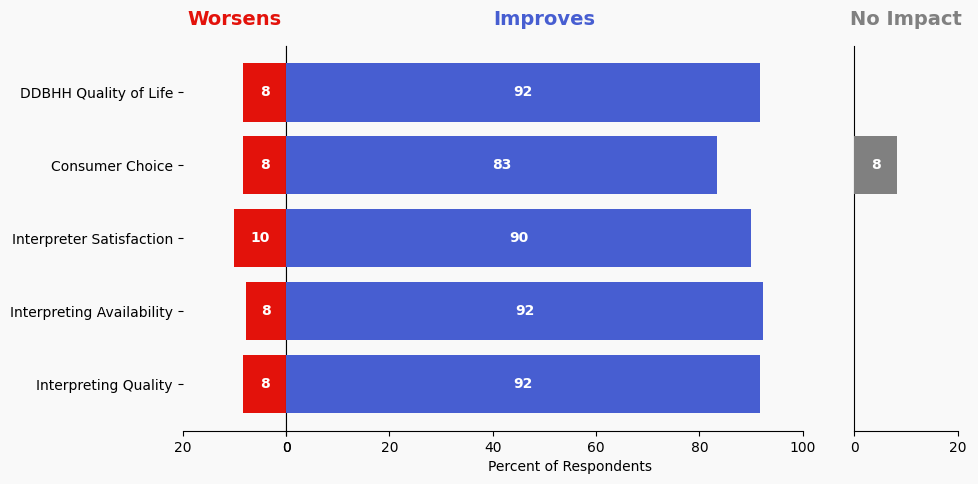63 Promote ASL for All High School Programs
Issue: Interpreter shortage.
Proposed Solution: Commission, MDE and stakeholders to develop and organize efforts to promote ASL classes in more of Minnesota’s high schools, ideally all high schools. Additionally, encourage more ASL 3 level classes as this leads to higher proficiency for college entrance to ITPs.
Expected outcome: Greater employability for DDBHH as ASL teachers, increase the flow into the interpreter pipeline and increase the overall number of people who have some familiarity with ASL and Deaf and DeafBlind culture.
Who is impacted: ASL students, ITP programs, ASL teachers
Timeline: 6 months
Note: Highlight the compelling research about the benefits of any person learning ASL.

Summary of Support Image Description
The stacked bar charts show how respondents rated their level of support and the total number of responses. The percentage for the five support levels is shown from left to right: Strongly Oppose (Dark Red), Oppose (Light Red), Neutral (Yellow), Support (Light Blue), and Strongly Support (Dark Blue).
Respondents may identify with multiple subgroups. The overall level of support is:
Overall
Strongly Oppose: 1%
Oppose: 1%
Neutral: 7%
Support: 28%
Strongly Support: 63%
Click to see the detailed image description for each subgroup.
Interpreter
Strongly Oppose: 0%
Oppose: 0%
Neutral: 7%
Support: 30%
Strongly Support: 64%
Greater Minnesota
Strongly Oppose: 3%
Oppose: 0%
Neutral: 10%
Support: 37%
Strongly Support: 50%
DDBHH Consumer
Strongly Oppose: 2%
Oppose: 2%
Neutral: 8%
Support: 31%
Strongly Support: 57%
System Stakeholder
Strongly Oppose: 0%
Oppose: 2%
Neutral: 11%
Support: 33%
Strongly Support: 53%
Overview of Respondents Opting for In-Depth Solution Analysis
After indicating their support level, 8% of the 134 respondents opted in to further assess whether the solution would worsen or improve on five metrics. Of the opt-in reviewers (12 respondents), 75% supported the solution, 16% were neutral on the solution, and 8% opposed the solution.
The remaining 122 respondents did not opt in to further assess the solution. Of these people, 92% support the solution, 6% were neutral on the solution, and 0% opposed the solution.
Reviewer Evaluation of Solution Effectiveness

Solution Effectiveness Image Description
The stacked bar charts show how respondents assessed the effectiveness of this solution based on five metrics. For each metric, the percentage of respondents is shown from left to right: Worsens (Red), Improves (Blue), No Impact (Gray).
DDBHH Quality of Life
Makes It Worse 8%
Makes It Better 91%
No Impact 0%
Interpreter Satisfaction
Makes It Worse 10%
Makes It Better 90%
No Impact 0%
Consumer Choice
Makes It Worse 8%
Makes It Better 83%
No Impact 8%
Interpreting Availability
Makes It Worse 7%
Makes It Better 92%
No Impact 0%
Interpreting Quality
Makes It Worse 8%
Makes It Better 91%
No Impact 0%
Reviewer Feedback and Insights
Interpreter
Comments from Interpreters express concerns about ensuring Deaf individuals are involved in teaching ASL to avoid hearing domice in the classroom. Another comment suggests include offering ASL as a college course credit for high school students.
Deaf, DeafBlind, Hard of Hearing
Comments from DDBHH Consumers highlight the challenge of promoting ASL in Greater Minnesota due to potential isolation of Deaf individuals. One comment raises concerns about hearing individuals teaching ASL without the necessary expertise. One comment suggests focusing on targeting inner-city schools and increasing ASL and interpreting career exposure to BIPOC communities.
System Stakeholder
Comments from System stakeholders suggest collaborating with school districts to start ASL classes, promoting ASL teaching as a career option, and developing a clear certification path for ASL educators.
PREVIOUS SOLUTION
62 Secure Funding for Greater Minnesota Interpreter Training Program (ITP)
Issue: Interpreter Shortage. Minnesota’s ITPs are all in the Twin Cities. While Augustana University in Sioux Falls, SD has an ITP and College of St. Scholastica in Duluth is considering an ITP, the rest of Greater Minnesota would only have a few online ITP options.
NEXT SOLUTION
64 Campaign to Support Interpreters in Greater Minnesota Being Hired by Local State Agency Offices
Issue: Consistent work options for Greater Minnesota freelance interpreters has been a challenge. Only interpreter referral companies are included in the vendor list for the state.
Leave a Reply